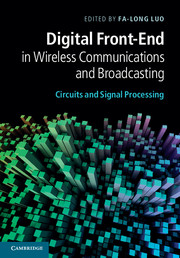Book contents
- Frontmatter
- Contents
- Contributors
- Preface
- Part I Introduction to digital front-end
- 1 Introduction to wireless communications and digital broadcasting
- 2 Basic principles and protocols of digital wireless communications
- 3 Digital front-end and system overview in wireless communication
- 4 System overview and front-end technologies in digital broadcasting
- 5 Digital front-end for multiple standards and multimode compatibility
- Part II DPD and CFR
- Part III DUC, DDC, ADC, DAC, and NCO
- Part IV Digital calibration, imbalance compensation, and error corrections
- Part V Circuits and system integration in digital front-end
- Index
- References
1 - Introduction to wireless communications and digital broadcasting
from Part I - Introduction to digital front-end
Published online by Cambridge University Press: 07 October 2011
- Frontmatter
- Contents
- Contributors
- Preface
- Part I Introduction to digital front-end
- 1 Introduction to wireless communications and digital broadcasting
- 2 Basic principles and protocols of digital wireless communications
- 3 Digital front-end and system overview in wireless communication
- 4 System overview and front-end technologies in digital broadcasting
- 5 Digital front-end for multiple standards and multimode compatibility
- Part II DPD and CFR
- Part III DUC, DDC, ADC, DAC, and NCO
- Part IV Digital calibration, imbalance compensation, and error corrections
- Part V Circuits and system integration in digital front-end
- Index
- References
Summary
The purpose of communication engineering is to transmit information from its source to the destination over some distance away. A basic communication system mainly consists of three essential components: transmitter, channel (wired or wireless), and receiver. Figure 1.1 shows a typical point-to-point one-way communication system. For a two-way system, a receiver and a transmitter are both required on each side.
The transmitter transforms the input signal to a transmission signal that is suitable for the characteristic of the channel. Since a channel is always varying with time, and the input signal to the system differs, the transmitter processes the input signal to produce a suitable signal for transmission. This generally includes the modulation and the coding. After being processed by the transmitter, the transmitted signal goes into the channel. The channel can be any medium or interface suitable for the transmission and it connects the transmitter and the receiver. The channel may be the laser beam, coaxial cable, or radio wave. During the transmission, there are various unwanted effects on the signals. Attenuation and power loss reduce the signal strength and make the detection difficult at the receiver. Besides the power loss and the attenuation, the channel may always introduce some undesired signals. These signals may be random and unpredictable signals that exist in nature, such as solar radiation, or the signals produced by other transmitters or machines. We call the former type of undesired signal “noise” and the latter type “interference.” If the interfering signals occupy different frequencies of the desired signal, using proper filters can remove these interferences. In comparison, the random noise that superimposes on the information-bearing signals is hard to completely eliminate by the filter and the remaining noise will inevitably corrupt the desired signal. The power ratio of received signal over noise decides the channel capacity which is one of the basic system performance parameters. After the receiver picks up the signal from the channel, it will do some filtering to compensate for the power loss, followed by demodulation and decoding to recover the original input signals.
- Type
- Chapter
- Information
- Digital Front-End in Wireless Communications and BroadcastingCircuits and Signal Processing, pp. 3 - 27Publisher: Cambridge University PressPrint publication year: 2011



